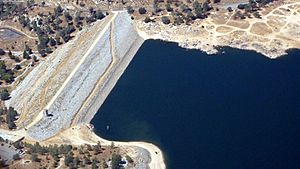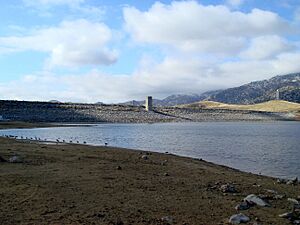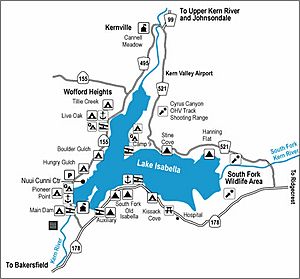Isabella Dam facts for kids
Quick facts for kids Isabella Dam |
|
|---|---|
| Location | Kern County, California |
| Coordinates | 35°38′46″N 118°28′56″W / 35.64611°N 118.48222°W |
| Construction began | 1948 |
| Opening date | 1953 |
| Operator(s) | |
| Dam and spillways | |
| Impounds | Lower Kern River |
| Height | 185 ft (56 m) |
| Length | 1,695 ft (517 m) |
| Spillways | Ungated concrete overflow |
| Spillway capacity | 49,000 cu ft/s (1,400 m3/s) |
| Reservoir | |
| Creates | Lake Isabella |
| Total capacity | 568,000 acre⋅ft (0.701 km3) |
| Catchment area | 2,074 sq mi (5,370 km2) |
| Surface area | 11,000 acres (4,500 ha) |
| Power station | |
| Installed capacity | 12 MW |
| Annual generation | 22,610,000 KWh (2001–2012) |
Isabella Dam is a large embankment dam in California. It sits in the Kern River Valley, between the towns of Kernville and Lake Isabella in Kern County.
This important dam helps with farming, making electricity, and controlling floods. The huge lake it creates, called Lake Isabella, is also a popular spot for fun activities. People love to visit for water sports, fishing, boating, camping, and hiking, especially in the nearby Sequoia National Forest.
Contents
Why Isabella Dam Was Built
The town of Isabella was founded in 1893. Years later, in 1948, the government decided to build a dam here. The main reason was to stop the city of Bakersfield from flooding. Bakersfield had been hit by big floods in 1867 and 1893.
Even while the dam was being built in 1950, the area experienced another large flood. The dam was finally finished in March 1953. The U.S. Army Corps of Engineers built two earthen dams across parts of the Kern River. This created Lake Isabella, which is Kern County's biggest body of water all year round.
Moving Towns for the Dam
Building the dam and the large lake meant that two towns, Lake Isabella and Kernville, had to be moved. They were rebuilt on higher ground to make way for the new reservoir. Most of the original town of Kernville was taken down in 1948 to prepare for the dam's construction.
The Kern River's Journey
After passing Isabella Dam, the Kern River flows southwest through a deep canyon. This canyon, known as Kern Canyon, has many steep cliffs. It's about 30 miles long and is located near the Greenhorn Mountains. When the river reaches Bakersfield, much of its water is used up or sent into channels.
The dam project protects Bakersfield and a huge area of farmland and oil fields. Isabella Dam also works with other dams on rivers like the Kings, Kaweah, and Tule. This helps prevent flood damage to farms in the Tulare Lake Basin.
Building and Running the Dam
Bakersfield suffered a lot of damage from a major flood in 1937. In 1943, floods caused millions of dollars in damage to farms in the Tulare Lake Basin. The Kern River was a big part of what caused that damage.
Because of these floods, the U.S. Army Corps of Engineers studied the area. They found that building a dam on the Kern River would greatly help with flood control. It would also help with irrigation for farms and create power. Based on their findings, Congress approved the Isabella Project in 1944.
Construction Details
Construction of Isabella Dam began in 1948 and was finished in 1953. The entire project cost a lot of money, but it was seen as very important for the region.
Isabella Dam is actually made of two dams: a "main dam" and an "auxiliary dam." The main dam is built from earth and is about 1,695 feet (517 m) long and 98 feet (30 m) tall. The U.S. Army Corps of Engineers owns and takes care of it. Lake Isabella, the main reservoir, can hold a massive amount of water.
Water from Lake Isabella can be used in a few ways. It can be released into the Lower Kern River, or it can go through hydroelectric projects at both the main and auxiliary dams to make electricity.
Borel Hydroelectric Project
Making electricity from the Kern River started way back in 1894. The Borel Hydroelectric Project was built to power the "Red Car" streetcar system in Los Angeles.
When Isabella Dam was built, it cut across the Borel canal, which was part of the power project. So, the U.S. Army Corps of Engineers made an agreement. They promised to build the dam in a way that would not stop the Borel project from getting all the water it needed from the Kern River. They also agreed to run the dam so it wouldn't mess with the Borel project's power production.
The auxiliary dam is part of this Borel Hydroelectric Project. Water for the Borel project was taken from the river about 5.5 miles (8.9 km) upstream of Isabella Dam. However, the Borel project stopped working in 2018. The part of the project that went through the Auxiliary Dam was sealed up in 2019.
Isabella Dam Restoration Project
More than 300,000 people live and work below the Isabella Dams, especially in the town of Lake Isabella and the city of Bakersfield. Because of this, the U.S. Army Corps of Engineers (USACE) started studying the dam's safety in 2006. They wanted to fix any problems with earthquakes, floods, or water leaking through the dam.
Safety Concerns and Solutions
In April 2006, a leak was found in the Isabella Auxiliary Dam. Officials had to lower the lake's water level to make it safer. They increased the amount of water released from the dam.
In May 2006, heavy rain and snowmelt caused the Upper Kern River to fill Lake Isabella very quickly. The Lower Kern River also ran very high and fast. This caused some roads to become unstable and some flooding for people living along the river. Officials warned that if Isabella Dam broke when the lake was full, a large part of Bakersfield could be underwater in just a few hours.
The dam was also found to be on a fault line. While it was thought to be inactive, a 2007 study found evidence of past earthquakes. This meant the fault line was active. Even with this new information, the study said the dam was likely safe. However, in November 2007, a report confirmed the dam was high-risk. It was ranked among the highest priority dams in America for safety improvements.
Planning for the Future
In 2008, local officials started making evacuation plans in case the dam ever failed. In 2012, the Corps of Engineers shared their plans for the dam's future. These plans included making the dam stronger to protect people and property from floods, earthquakes, and leaks.
The plans involved raising both dams by about 16 feet (4.9 m). They also planned a new 900 feet (270 m) emergency spillway. Roads like State Route 155 and State Route 178 would also be moved higher. These changes were designed to have less impact on recreation, wildlife, and water quality.
In 2014, the Corps began testing a model of the project at Utah State University. This model was huge, about one-third the size of a football field! The actual construction started in 2018 and is expected to be finished in 2022.
The project will not increase how much water the dam can hold. However, during construction, the water level will be lowered on purpose if needed. The Corps is also working to reduce any negative effects on recreation. They have put in place extra monitoring, warning sirens, and public outreach to keep everyone safe while the dam is being improved.
In September 2017, a large contract was given to a company to make the dam modifications. This work includes digging a new emergency spillway, changing the existing spillway, raising the main dam, and making changes to nearby roads and recreation areas.
Recreation
The area around Lake Isabella is a fantastic place for outdoor fun! There are over 30 campgrounds around the lake, many of them inside the Sequoia National Forest. This forest has thousands of miles of roads and trails, plus many places for camping and other activities. It's also next to Sequoia and Kings Canyon National Parks.
You can go sport fishing in Lake Isabella all year round. The lake is filled with fish like trout, bass, bluegill, crappie, and catfish. You can also enjoy many water sports on the lake, including boating, sailing, jet skiing, water skiing, and wind surfing. Permits for boating and fishing are easy to get at marinas and local stores. Along the Kern River, you can also go whitewater rafting, kayaking, and fishing.
Images for kids





